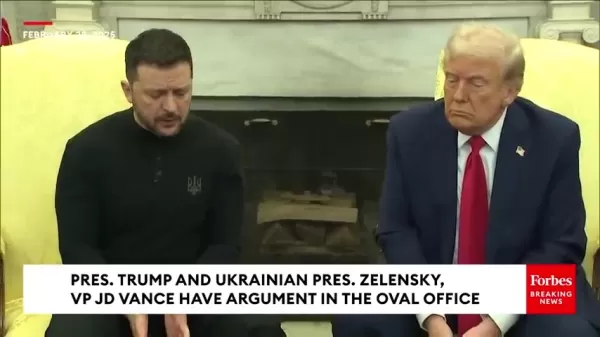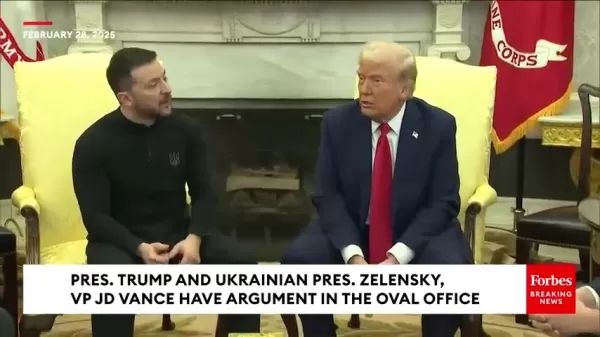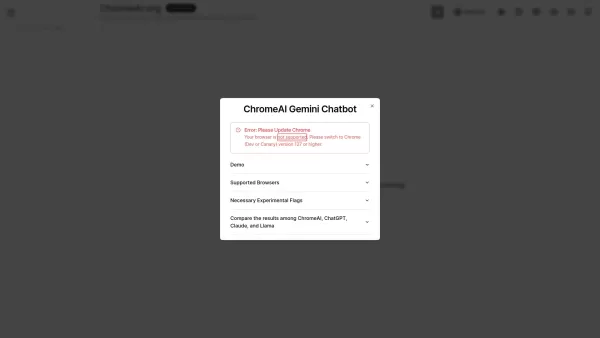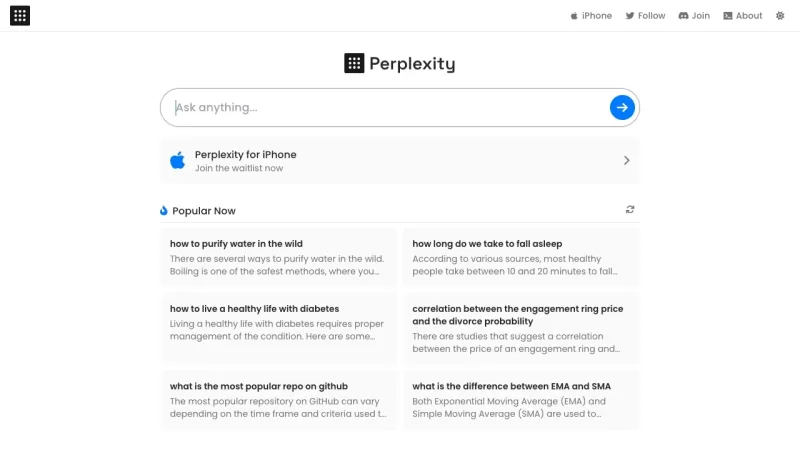Trump, Zelensky, and Vance Clash in Heated Oval Office Debate

 April 24, 2025
April 24, 2025

 NicholasRoberts
NicholasRoberts

 0
0
In a surprising twist, the Oval Office recently became the stage for a heated debate between President Trump, Ukrainian President Zelensky, and Vice President JD Vance. What began as a discussion on diplomatic strategies and the ongoing crisis in Ukraine quickly turned into a fiery argument, spotlighting the complexities of international relations and the U.S.'s role on the world stage. This article explores the details of the confrontation, the main points of contention, and the potential repercussions for Ukraine and beyond. The argument underscores the differing views on handling foreign policy, particularly with regards to Russia and its President, Vladimir Putin. This event brings to light the intricate dynamics the U.S. faces in maintaining relationships with both allies and adversaries.
Key Points
- President Trump, President Zelensky, and VP JD Vance had a heated argument in the Oval Office.
- The discussion focused on diplomatic approaches to Russia and the situation in Ukraine.
- Zelensky voiced concerns about aligning too closely with Putin, while Trump defended his approach as essential for deal-making.
- Vance stressed the importance of actions over words in foreign policy.
- The exchange revealed differing views on the best way to achieve peace and prosperity for Ukraine.
The Oval Office Showdown
An Argument Unfolds
The Oval Office, a symbol of American power and diplomacy, turned into the arena for a contentious debate. The argument reportedly stemmed from Zelensky's worries about what his Polish friends saw as Trump's overly friendly stance towards Putin. Zelensky confronted Trump directly, questioning his message to those concerned about this alignment.
Trump defended his diplomatic approach, arguing that maintaining a working relationship with both Zelensky and Putin was vital for any resolution. He questioned the effectiveness of constant public condemnation, suggesting it would hinder meaningful negotiations. This led to a heated exchange, revealing a stark difference in opinion on managing complex international relations. The mention of 'hatred' and 'love' from opposing sides clearly indicated the deep divide between them.
This exchange offered a rare insight into the behind-the-scenes disagreements that shape foreign policy decisions. It highlighted the challenge of balancing alliances with the need for open communication, even with those considered adversaries, and raised significant questions about the direction of U.S. foreign policy.
Vance Enters the Fray: Words vs. Actions
Vice President JD Vance jumped into the fray, adding another layer of complexity to the already tense atmosphere. Vance challenged the efficacy of merely 'talking tough' about Putin, citing past administrations where strong rhetoric failed to deter Russian aggression.
Vance argued that actions speak louder than words, criticizing what he described as the Biden administration's 'thumping our chest' approach. He advocated for true American strength to be found in engaging in diplomacy, even when it's difficult. Vance's stance differed from that of both past and present presidents, focusing on a more pragmatic, results-oriented foreign policy.
His comments underscored a growing debate about the role of American power in the 21st century. Should the U.S. prioritize projecting strength and confronting adversaries, or should it focus on building relationships and fostering dialogue? Vance's remarks suggest a shift towards a more pragmatic approach in foreign policy.

Zelensky's Rebuttal: A History of Unfulfilled Promises
Zelensky, visibly impassioned, countered Vance's arguments by pointing to a history of broken agreements and unfulfilled promises. He cited the 2014 annexation of Crimea as a prime example, arguing that despite years of conversations and agreements with Putin, Russia continued its aggression.
He mentioned that his friends had warned him of this happening, and that Ukraine was suffering alone, with no help from the U.S., and the situation was deteriorating. He noted that every president since Obama had faced this issue, and the current president seemed to want to act as if they didn't exist.
Zelensky also revealed further damning details, such as prisoners of war not being released by Putin despite promises. His passionate defense highlighted the deep-seated distrust between Ukraine and Russia, making it difficult to envision a path towards a peaceful resolution. He argued that Putin could not be trusted, suggesting that all diplomacy would ultimately fail. This underscored the difficulty of finding common ground when historical grievances and fundamental differences in worldview are at play.

The Core of the Argument: Different Philosophies
At its heart, the Oval Office showdown reflected a clash of different philosophies regarding foreign policy. Trump's approach, characterized by personal diplomacy and a focus on deal-making, often prioritizes maintaining relationships, even with controversial figures. Vance, on the other hand, emphasized the importance of consistent action and results, suggesting that the U.S. should lead by example through positive actions. Zelensky focused on a historic pattern of Russian aggression, making him skeptical of any diplomatic solution that relies on trust.
These differing perspectives raise fundamental questions about the nature of international relations. Is it possible to achieve lasting peace through negotiation, or is confrontation sometimes necessary to deter aggression? What is the proper balance between pragmatism and principle in foreign policy decision-making?
The argument underscored the inherent challenges of navigating a complex and ever-changing world, where there are no easy answers and differing perspectives often collide.

Understanding the Geopolitical Context
The Significance of Ukraine
Ukraine holds a strategically vital position in Eastern Europe, bordering Russia and serving as a bridge between East and West. Its geopolitical importance has made it a focal point of tensions between Russia and the West for decades. Russia views Ukraine as part of its sphere of influence.
The current conflict in Ukraine is rooted in a complex history, including the collapse of the Soviet Union, Ukraine's aspirations to join NATO, and Russia's concerns about Western expansion. Understanding these historical factors is crucial for comprehending the nuances of the ongoing situation and the challenges of finding a lasting solution.
The US-Russia Relationship: A Complex Dynamic
The relationship between the United States and Russia has long been characterized by a mixture of cooperation and competition. While the two countries have collaborated on issues such as arms control and counter-terrorism, they have also clashed over geopolitical interests and ideological differences.
The U.S. has sought to support Ukraine's sovereignty and territorial integrity. However, Russia views this as an encroachment on its sphere of influence and has taken steps to destabilize Ukraine. These competing interests have created a volatile situation, making it difficult to find common ground.
America's Role in a Changing World
The Oval Office argument also raises questions about the United States' role in a changing world order. Should the U.S. continue to act as a global policeman, intervening in conflicts and promoting democracy around the world, or should it adopt a more restrained approach, focusing on its own interests and security?
This debate has been ongoing in American politics for decades and has become even more relevant in recent years as the U.S. faces new challenges such as the rise of China, the threat of terrorism, and the spread of authoritarianism. The path the U.S. chooses will significantly influence the global landscape.
Diplomacy vs. Confrontation: Weighing the Options
Pros
- Reduces the risk of military escalation and conflict.
- Provides opportunities for dialogue and compromise.
- Can lead to cooperation on issues of mutual interest, such as arms control and counter-terrorism.
- May foster greater stability and predictability in the international system.
Cons
- May embolden Russia to continue its aggression and disregard international norms.
- Can be perceived as appeasement and a sign of weakness.
- May fail to address fundamental differences in worldview and geopolitical interests.
- Requires a willingness to compromise on core values and principles.
Frequently Asked Questions
What was the main topic of the argument in the Oval Office?
The main topic was diplomatic approaches to Russia and the situation in Ukraine, with disagreements arising over aligning with Putin and the effectiveness of different strategies.
What were Zelensky's main concerns?
Zelensky expressed concerns that Trump was aligning too closely with Putin and emphasized a history of broken agreements and unfulfilled promises by Russia.
What was Vance's perspective on the situation?
Vance highlighted the importance of actions over words in foreign policy, criticizing what he characterized as the Biden administration's 'thumping our chest' approach.
Did the video reveal any new information about the relationship between the three countries involved?
The video provided a rare glimpse into the behind-the-scenes disagreements that often shape foreign policy decisions and highlighted the complexity of balancing alliances with the need for open communication.
What are the potential implications of this argument for the future of Ukraine?
The implications are uncertain, but the differing perspectives suggest a potential shift in U.S. foreign policy towards a more pragmatic, results-oriented approach, which could have consequences for Ukraine's future.
Related Questions
How have past US administrations handled relations with Russia?
Past administrations have employed various strategies, ranging from détente and arms control agreements to sanctions and military containment. The specific approach has often depended on the political climate, the perceived threat from Russia, and the personal relationship between the U.S. president and the Russian leader. However, the history of relations has been turbulent. From the Cold War to post-Soviet cooperation, different presidents have taken different approaches to Russian relations, and none have fully succeeded. Examining the history of U.S. administrations allows us to see which options have been most commonly used and which have historically failed. For instance, one example of this is...
Regardless of the overall strategy, maintaining open lines of communication has been a common thread throughout the history of U.S.-Russian relations. Even during periods of high tension, dialogue has been seen as essential for preventing misunderstandings and managing crises. The debate is whether that level of 'friendship' means you are not able to fairly and accurately advocate for your own country.
It's also important to note that U.S. policy toward Russia is often influenced by domestic political factors. Public opinion, congressional oversight, and interest group pressure can all play a role in shaping the administration's approach. Therefore, navigating a proper path can be challenging.
Related article
 Explore Earth Virtually: ChatGPT and Google Earth Vacation Planner
Ever felt the urge to escape the daily grind but found yourself stumped on where to go? Let's dive into a cool way to plan your next getaway without even stepping outside your door. By harnessing the power of ChatGPT and Google Earth, you can embark on a virtual vacation that's both exciting and rel
Explore Earth Virtually: ChatGPT and Google Earth Vacation Planner
Ever felt the urge to escape the daily grind but found yourself stumped on where to go? Let's dive into a cool way to plan your next getaway without even stepping outside your door. By harnessing the power of ChatGPT and Google Earth, you can embark on a virtual vacation that's both exciting and rel
 ChatGPT's Unsolicited Use of User Names Sparks 'Creepy' Concerns Among Some
Some users of ChatGPT have recently encountered an odd new feature: the chatbot occasionally uses their name while working through problems. This wasn't part of its usual behavior before, and many users report that ChatGPT mentions their names without ever being told what to call them.
Opinions on
ChatGPT's Unsolicited Use of User Names Sparks 'Creepy' Concerns Among Some
Some users of ChatGPT have recently encountered an odd new feature: the chatbot occasionally uses their name while working through problems. This wasn't part of its usual behavior before, and many users report that ChatGPT mentions their names without ever being told what to call them.
Opinions on
 AI Optimizes Production Through Capacity Constraint Job Scheduling
In today's competitive manufacturing world, fine-tuning production processes is essential for cutting costs and boosting efficiency. One major hurdle is capacity constraint job scheduling, which involves juggling limited resources and intricate dependencies to meet customer needs. Innotock AI steps
Comments (0)
0/200
AI Optimizes Production Through Capacity Constraint Job Scheduling
In today's competitive manufacturing world, fine-tuning production processes is essential for cutting costs and boosting efficiency. One major hurdle is capacity constraint job scheduling, which involves juggling limited resources and intricate dependencies to meet customer needs. Innotock AI steps
Comments (0)
0/200

 April 24, 2025
April 24, 2025

 NicholasRoberts
NicholasRoberts

 0
0
In a surprising twist, the Oval Office recently became the stage for a heated debate between President Trump, Ukrainian President Zelensky, and Vice President JD Vance. What began as a discussion on diplomatic strategies and the ongoing crisis in Ukraine quickly turned into a fiery argument, spotlighting the complexities of international relations and the U.S.'s role on the world stage. This article explores the details of the confrontation, the main points of contention, and the potential repercussions for Ukraine and beyond. The argument underscores the differing views on handling foreign policy, particularly with regards to Russia and its President, Vladimir Putin. This event brings to light the intricate dynamics the U.S. faces in maintaining relationships with both allies and adversaries.
Key Points
- President Trump, President Zelensky, and VP JD Vance had a heated argument in the Oval Office.
- The discussion focused on diplomatic approaches to Russia and the situation in Ukraine.
- Zelensky voiced concerns about aligning too closely with Putin, while Trump defended his approach as essential for deal-making.
- Vance stressed the importance of actions over words in foreign policy.
- The exchange revealed differing views on the best way to achieve peace and prosperity for Ukraine.
The Oval Office Showdown
An Argument Unfolds
The Oval Office, a symbol of American power and diplomacy, turned into the arena for a contentious debate. The argument reportedly stemmed from Zelensky's worries about what his Polish friends saw as Trump's overly friendly stance towards Putin. Zelensky confronted Trump directly, questioning his message to those concerned about this alignment.
Trump defended his diplomatic approach, arguing that maintaining a working relationship with both Zelensky and Putin was vital for any resolution. He questioned the effectiveness of constant public condemnation, suggesting it would hinder meaningful negotiations. This led to a heated exchange, revealing a stark difference in opinion on managing complex international relations. The mention of 'hatred' and 'love' from opposing sides clearly indicated the deep divide between them.
This exchange offered a rare insight into the behind-the-scenes disagreements that shape foreign policy decisions. It highlighted the challenge of balancing alliances with the need for open communication, even with those considered adversaries, and raised significant questions about the direction of U.S. foreign policy.
Vance Enters the Fray: Words vs. Actions
Vice President JD Vance jumped into the fray, adding another layer of complexity to the already tense atmosphere. Vance challenged the efficacy of merely 'talking tough' about Putin, citing past administrations where strong rhetoric failed to deter Russian aggression.
Vance argued that actions speak louder than words, criticizing what he described as the Biden administration's 'thumping our chest' approach. He advocated for true American strength to be found in engaging in diplomacy, even when it's difficult. Vance's stance differed from that of both past and present presidents, focusing on a more pragmatic, results-oriented foreign policy.
His comments underscored a growing debate about the role of American power in the 21st century. Should the U.S. prioritize projecting strength and confronting adversaries, or should it focus on building relationships and fostering dialogue? Vance's remarks suggest a shift towards a more pragmatic approach in foreign policy.

Zelensky's Rebuttal: A History of Unfulfilled Promises
Zelensky, visibly impassioned, countered Vance's arguments by pointing to a history of broken agreements and unfulfilled promises. He cited the 2014 annexation of Crimea as a prime example, arguing that despite years of conversations and agreements with Putin, Russia continued its aggression.
He mentioned that his friends had warned him of this happening, and that Ukraine was suffering alone, with no help from the U.S., and the situation was deteriorating. He noted that every president since Obama had faced this issue, and the current president seemed to want to act as if they didn't exist.
Zelensky also revealed further damning details, such as prisoners of war not being released by Putin despite promises. His passionate defense highlighted the deep-seated distrust between Ukraine and Russia, making it difficult to envision a path towards a peaceful resolution. He argued that Putin could not be trusted, suggesting that all diplomacy would ultimately fail. This underscored the difficulty of finding common ground when historical grievances and fundamental differences in worldview are at play.

The Core of the Argument: Different Philosophies
At its heart, the Oval Office showdown reflected a clash of different philosophies regarding foreign policy. Trump's approach, characterized by personal diplomacy and a focus on deal-making, often prioritizes maintaining relationships, even with controversial figures. Vance, on the other hand, emphasized the importance of consistent action and results, suggesting that the U.S. should lead by example through positive actions. Zelensky focused on a historic pattern of Russian aggression, making him skeptical of any diplomatic solution that relies on trust.
These differing perspectives raise fundamental questions about the nature of international relations. Is it possible to achieve lasting peace through negotiation, or is confrontation sometimes necessary to deter aggression? What is the proper balance between pragmatism and principle in foreign policy decision-making?
The argument underscored the inherent challenges of navigating a complex and ever-changing world, where there are no easy answers and differing perspectives often collide.

Understanding the Geopolitical Context
The Significance of Ukraine
Ukraine holds a strategically vital position in Eastern Europe, bordering Russia and serving as a bridge between East and West. Its geopolitical importance has made it a focal point of tensions between Russia and the West for decades. Russia views Ukraine as part of its sphere of influence.
The current conflict in Ukraine is rooted in a complex history, including the collapse of the Soviet Union, Ukraine's aspirations to join NATO, and Russia's concerns about Western expansion. Understanding these historical factors is crucial for comprehending the nuances of the ongoing situation and the challenges of finding a lasting solution.
The US-Russia Relationship: A Complex Dynamic
The relationship between the United States and Russia has long been characterized by a mixture of cooperation and competition. While the two countries have collaborated on issues such as arms control and counter-terrorism, they have also clashed over geopolitical interests and ideological differences.
The U.S. has sought to support Ukraine's sovereignty and territorial integrity. However, Russia views this as an encroachment on its sphere of influence and has taken steps to destabilize Ukraine. These competing interests have created a volatile situation, making it difficult to find common ground.
America's Role in a Changing World
The Oval Office argument also raises questions about the United States' role in a changing world order. Should the U.S. continue to act as a global policeman, intervening in conflicts and promoting democracy around the world, or should it adopt a more restrained approach, focusing on its own interests and security?
This debate has been ongoing in American politics for decades and has become even more relevant in recent years as the U.S. faces new challenges such as the rise of China, the threat of terrorism, and the spread of authoritarianism. The path the U.S. chooses will significantly influence the global landscape.
Diplomacy vs. Confrontation: Weighing the Options
Pros
- Reduces the risk of military escalation and conflict.
- Provides opportunities for dialogue and compromise.
- Can lead to cooperation on issues of mutual interest, such as arms control and counter-terrorism.
- May foster greater stability and predictability in the international system.
Cons
- May embolden Russia to continue its aggression and disregard international norms.
- Can be perceived as appeasement and a sign of weakness.
- May fail to address fundamental differences in worldview and geopolitical interests.
- Requires a willingness to compromise on core values and principles.
Frequently Asked Questions
What was the main topic of the argument in the Oval Office?
The main topic was diplomatic approaches to Russia and the situation in Ukraine, with disagreements arising over aligning with Putin and the effectiveness of different strategies.
What were Zelensky's main concerns?
Zelensky expressed concerns that Trump was aligning too closely with Putin and emphasized a history of broken agreements and unfulfilled promises by Russia.
What was Vance's perspective on the situation?
Vance highlighted the importance of actions over words in foreign policy, criticizing what he characterized as the Biden administration's 'thumping our chest' approach.
Did the video reveal any new information about the relationship between the three countries involved?
The video provided a rare glimpse into the behind-the-scenes disagreements that often shape foreign policy decisions and highlighted the complexity of balancing alliances with the need for open communication.
What are the potential implications of this argument for the future of Ukraine?
The implications are uncertain, but the differing perspectives suggest a potential shift in U.S. foreign policy towards a more pragmatic, results-oriented approach, which could have consequences for Ukraine's future.
Related Questions
How have past US administrations handled relations with Russia?
Past administrations have employed various strategies, ranging from détente and arms control agreements to sanctions and military containment. The specific approach has often depended on the political climate, the perceived threat from Russia, and the personal relationship between the U.S. president and the Russian leader. However, the history of relations has been turbulent. From the Cold War to post-Soviet cooperation, different presidents have taken different approaches to Russian relations, and none have fully succeeded. Examining the history of U.S. administrations allows us to see which options have been most commonly used and which have historically failed. For instance, one example of this is...
Regardless of the overall strategy, maintaining open lines of communication has been a common thread throughout the history of U.S.-Russian relations. Even during periods of high tension, dialogue has been seen as essential for preventing misunderstandings and managing crises. The debate is whether that level of 'friendship' means you are not able to fairly and accurately advocate for your own country.
It's also important to note that U.S. policy toward Russia is often influenced by domestic political factors. Public opinion, congressional oversight, and interest group pressure can all play a role in shaping the administration's approach. Therefore, navigating a proper path can be challenging.
 Explore Earth Virtually: ChatGPT and Google Earth Vacation Planner
Ever felt the urge to escape the daily grind but found yourself stumped on where to go? Let's dive into a cool way to plan your next getaway without even stepping outside your door. By harnessing the power of ChatGPT and Google Earth, you can embark on a virtual vacation that's both exciting and rel
Explore Earth Virtually: ChatGPT and Google Earth Vacation Planner
Ever felt the urge to escape the daily grind but found yourself stumped on where to go? Let's dive into a cool way to plan your next getaway without even stepping outside your door. By harnessing the power of ChatGPT and Google Earth, you can embark on a virtual vacation that's both exciting and rel
 ChatGPT's Unsolicited Use of User Names Sparks 'Creepy' Concerns Among Some
Some users of ChatGPT have recently encountered an odd new feature: the chatbot occasionally uses their name while working through problems. This wasn't part of its usual behavior before, and many users report that ChatGPT mentions their names without ever being told what to call them.
Opinions on
ChatGPT's Unsolicited Use of User Names Sparks 'Creepy' Concerns Among Some
Some users of ChatGPT have recently encountered an odd new feature: the chatbot occasionally uses their name while working through problems. This wasn't part of its usual behavior before, and many users report that ChatGPT mentions their names without ever being told what to call them.
Opinions on
 AI Optimizes Production Through Capacity Constraint Job Scheduling
In today's competitive manufacturing world, fine-tuning production processes is essential for cutting costs and boosting efficiency. One major hurdle is capacity constraint job scheduling, which involves juggling limited resources and intricate dependencies to meet customer needs. Innotock AI steps
AI Optimizes Production Through Capacity Constraint Job Scheduling
In today's competitive manufacturing world, fine-tuning production processes is essential for cutting costs and boosting efficiency. One major hurdle is capacity constraint job scheduling, which involves juggling limited resources and intricate dependencies to meet customer needs. Innotock AI steps
5 Easy Steps to Reclaim Your Online Data Privacy - Start Today
Is AI Diminishing Our Intelligence?































